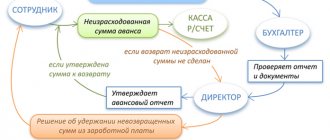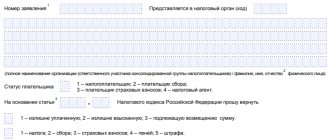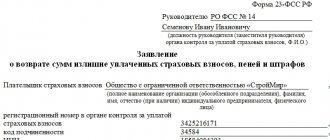Login for clients
For example, in the standard form of agreement established by Decree of the Government of the Moscow Region dated October 18, 2016 No. 758/38[1], there is no reference to the fact that in the agreement with a subordinate institution it is necessary to indicate a specific date for the return of balances. But in the standard form approved for federal AUs and BUs by Order of the Ministry of Finance of the Russian Federation dated October 31, 2016 No. 198n[2], there is an indication of the need to indicate the date, month and year following the year of provision of the subsidy as the return period. However, the founding bodies, as a rule, cannot arbitrarily choose the date before which the subordinate institutions must make the return. The founders are guided by the deadlines established in “superior” acts adopted at the federal, regional or municipal level.
In particular, a specific period can be determined in the budget law, a legal act containing measures to implement the law
The procedure for accounting in the GRBS operations for the accrual, receipt and transfer to budget revenue of amounts of receivables from the previous year
This procedure is established by paragraphs 80, 111, 102 of Instruction No. 162n, Instruction to the Unified Chart of Accounts No. 157n (accounts 205.00, 206.00, 302.00, 304.05, 401.20).
Accounting for the return of unused balances of targeted subsidies depends on the year in which the institution returns them - the current or the next. If unused balances were received in the current year, make an accounting entry: Debit KRB.1.304.05.241 Credit KRB.1.206.41.660 – reflects the return of targeted subsidies provided in the current year (as a restoration of cash expenses). If unused balances are received next year, make the following entries in accounting: Debit KDB.1.205.81.560 Credit KRB.1.206.41.660 – transformation of the unused balance of the targeted subsidy from previous years (based on the annual report on its use and the founder’s decision to return the balance); Debit KDB.1.210.02.180 Credit KDB.1.205.81.660 – reflects the return of the targeted subsidy to budget revenue.
Early termination of government assignments.
According to clause 41 of Regulation No. 640, in the event of early termination of the execution of a state task, the unused balances of the subsidy in the amount corresponding to the indicators characterizing the volume of unprovided public services (uncompleted work) are subject to transfer in the prescribed manner by budgetary or autonomous institutions to the budget and are taken into account in the manner prescribed for accounting for receivables returns.
The grounds for early termination of the execution of a state task are reflected in the state task itself (Clause 1, Article 69.2 of the Budget Code of the Russian Federation). These include:
- liquidation of the institution;
- adoption, in accordance with the established procedure, of a decision on the reorganization of an institution, as a result of which the institution ceases to operate as a legal entity;
- redistribution of powers, resulting in the exclusion from the competence of the institution of the authority to provide public services (carry out public work);
- changes in current regulatory legal acts, as a result of which the further implementation of the state task will contradict these acts;
- the occurrence (detection) during the implementation of a state task of circumstances that do not allow it to be completed for reasons beyond the control of the institution;
- poor quality performance of a government task or violation of the terms of such task;
- other cases provided for by the legislation of the Russian Federation.
In our opinion, in accounting, operations to return unused subsidy funds to the budget are reflected in the same way as the return of a subsidy in case of failure to fulfill a government task.
3
In the event of early termination of the execution of a state task in connection with the reorganization of a budgetary or autonomous institution, the unused balances of the subsidy are subject to transfer to the relevant budgetary and autonomous institutions that are legal successors (clause 41 of Regulation No. 640).
Return of targeted subsidies
Please note: the deadline for submitting information (f.
0501016) abbreviated. Last year, such information was submitted before July 1.
If information (f. 0501016) is not provided within the specified period, the territorial OFK no later than the tenth working day after June 1 of the current financial year (or the first working day following the named date) collects the balance of targeted subsidies by transferring them to an account opened on the balance sheet account 40101
“Revenues distributed by the bodies of the Federal Treasury between the budgets of the budget system of the Russian Federation”
, for subsequent transfer of the balances of targeted subsidies to the federal budget revenue (clause
3 Order No. 82n). At the same time, without waiting for the collection of the specified funds, the institution in the absence of approved information (f.
34 Decree of the Government of the Russian Federation dated December 9, 2017 No. 1496 “On measures to ensure the execution of the federal budget”)
What entries should be made in the accounting of a government institution to reflect an interbudgetary transfer.
How to reflect the transfer of transfers to another budget After the revenue administrator receives an interbudgetary transfer, he spends it for its intended purpose.
0501016) are obliged to independently transfer the corresponding unconfirmed balances of earmarked funds to the federal budget revenue no later than June 1 of the current financial year (clause.
Transfers may be received to transfer interbudgetary transfers to another budget. For example, a transfer from the federal budget is allocated to a government agency of a constituent entity of the Russian Federation, and a constituent entity of the Russian Federation, in turn, distributes the money to the municipality. Operations are formalized by notification (f. 0504817). In accounting, reflect the transfer of interbudgetary transfer to the district budget with the following entries: No. Contents of transaction Debit account Credit account 1.
An interbudgetary transfer was transferred to the municipality (based on an extract from the personal account) KRB.1.206.51.560 KRB.1.304.05.251 2. The expense is reflected in the form of a transfer transferred to the municipality (based on a report from the municipality on the use of the transfer) KRB.1.401.20.251 KRB.1.302.51.730 3.
Return of remaining subsidies from previous years
Depending on the purpose of spending the funds, the return of funds to the budget or another source is reflected in different ways:
| By capital expenditure |
|
| For current expenses |
|
Return of accounts receivable from previous years in a budgetary institution 2021
For example, in the Samara region, the return of accounts receivable from previous years is reflected as a restoration of cash expenses with reflection on the same BCC for which there was previously an expense (clause 5.6 of the Procedure, approved by order of the Ministry of Financial Management of the Samara Region dated December 13, 2007 No. 12-21/ 98). If a personal account is opened with the Federal Treasury, the procedure for recording transactions on personal accounts is approved: for budgetary institutions - by order of the Federal Treasury dated July 19, 2013 No. 11n; for autonomous institutions - by order of the Federal Treasury dated December 8, 2011 No. 15n.
We recommend reading: Early repayment of a mortgage with annuity payments
Now let's look at how the Federal Treasury authorities reflect the return of receivables on personal accounts. 1. Refund for a government order or paid activity. Return the receivables of the current financial year - reflect the restoration of cash expenses for the same CVR for which the payment was made.
2. Return on targeted subsidies or capital investments
Examples of basic postings in a government institution
At the same time, reduce the off-balance sheet account 02. In accounting, reflect the costs of purchasing intangible assets under article KOSGU 320, and non-produced assets - under article KOSGU 310.
To reflect the debt for supplies, use the following entries: Dt 1 106 32 320 Dt 1 302 32 73Х - intangible assets; Dt 1,106 13,330 Kt 1,302 33 73Х - non-produced assets. Payments to suppliers from a personal account in the Federal Treasury, show by posting: Dt 1 302 32 83Х Kt 1 304 05 320 – for intangible assets; Dt 1 302 33 83Х Kt 1 304 05 330 – for non-produced assets I will show you with an example how to capitalize inventories on the balance sheet, how to put them into operation and write them off.
Example. A government agency purchased stationery worth 50,000 rubles. The accountant made the accounting entries.
DT 1 106 34 346 Kt 1 302 34 734 - 50 thousand rubles, edging goods arrived; Dt 1 105 36 346 Kt 1 106 34 346 - 50 thousand rubles, stationery accepted for accounting; Dt 1 302 34 834 Kt 1 304 05 346 - 50 thousand.
Necessary entries when returning subsidies from previous years to the regional budget
In this situation, it is most correct to identify the guilty person responsible for the intended use of budget funds (manager, chief accountant) and accrue debt on account 209 30.
and give the details of the local budget revenue administrator where to transfer the debt. You can check with the founder whether he will allocate additional funds to transfer the amount of misuse of budget funds.
In such a situation, the postings will be a reflection of other expenses of the government institution.
Justification How can the financial authority reflect in budget accounting and the Report (f. 0503324) the collection of interbudgetary transfers from the regional (local) budget into the federal budget. The auditors identified the misuse of transfers. The financial authority, as the revenue administrator, records transactions as a return of transfer balances.
The financial authority includes the amount of recovery in the Report on the use of interbudgetary transfers from the federal budget (f.
0503324). The territorial body of the Treasury of Russia collects the provided interbudgetary transfers if the financial authority, State Budgetary Service of the corresponding budget or the recipient of the funds: spent the money for other purposes; the balance was not returned on time; violated other conditions for spending transfers. The Treasury collects money from the account unconditionally.
To do this, a TOFK employee fills out a Refund Application (f.
0531803). Grounds: an order from the Russian Ministry of Finance or other regulatory agencies for collection, a notification of a decision to apply budget coercive measures. This is stated in paragraph 5 of Article 242, paragraph 3 of Article 306.4, Article 306.8 of the Budget Code of the Russian Federation, paragraphs 5, 6 of Appendix No. 1, paragraph 4 of Appendix No. 2 to Order of the Ministry of Finance of Russia dated June 11, 2009 No. 51n, paragraphs 3, 7 of the Procedure , approved by order of the Ministry of Finance of Russia dated August 11, 2014 No. 74n.
After you receive the documents on the collection of funds from the account, make the following entries in your accounting: No. Contents of the transaction Account debit Account credit 1. The amounts of the unused balance of the interbudgetary transfer of previous years restored in the current year have been accepted (based on a copy of the order of the Ministry of Finance of Russia on collection, notice of collection ) KDB.1.401.10.151 KDB.1.205.51.660 2. Calculations for the return to the federal budget of the balance of the interbudgetary transfer received last year are reflected (based on an accounting certificate (f.
0504833)) KDB.1.205.51.560 KDB.1.205.51.660 3.
The balance of the transfer to the federal budget was collected (based on an extract from the personal account of the budget revenue administrator) KDB.1.205.51.560 KDB.1.210.02.151 Such rules are established in paragraphs 78, 120 of Instruction No. 162n and confirmed in letters of the Ministry of Finance of Russia dated February 22, 2021 No. 02 -06-10/18528, No. 02-06-10/10520.
The financial authority reflects the collected amount in section 1 of the Report on the use of interbudgetary transfers (f.
0503324): in column 9 – the restored amount of the balance of the interbudgetary transfer of previous years; in column 10 – the amount of funds returned to the federal budget.
This is stated in letters of the Ministry of Finance of Russia dated February 22, 2021 No. 02-06-10/18528, No. 02-06-10/10520.
We recommend reading: Is it possible to get a foreign passport in less than a month in St. Petersburg
Which account classification feature should I use?
When choosing an analytical code based on the classification of receipts and disposals, you must be guided by Appendix 2 “The procedure for including the budget classification code of the Russian Federation when generating the budget accounting account number” to the Instructions, approved. By Order of the Ministry of Finance of Russia dated December 6, 2010 No. 162n.
Thus, according to this appendix to account 030305000, in terms of payments for income, the analytical budget income code (KDB) is used.
Therefore, when accruing debt for the return of unused balances of targeted subsidies to the budget, as well as when transferring these funds to account 030305000, a CPS of the KDB type is applied.
Reflection of the refund operation.
This code needs to be detailed based on the budget from which cash payments were made.
For example, if expenses were made through targeted subsidies from the federal budget, code 000 1 1300 130 is used.
In this case, in place of the 1st–3rd digits of the code, indicate the code of the main administrator. In place of the 14th–20th digits, indicate the code of the subtype of income.
This is stated in paragraph 4.1 of Section II of the instructions approved by Order of the Ministry of Finance dated July 1, 2013 No. 65n.1 When receivables can be used in the current year The institution has the right to use returned receivables from previous years in the current year if expenses were previously made at the expense of: · funds from the paid activities or through subsidies for government tasks; · targeted subsidy, if there is permission from the founder. This is stated in parts 17–18 of Article 30 of the Law of 05/08/2010 No. 83-FZ, part 3.15 of Article 2 of the Law of 03/11/2006 No. 174-FZ.
In these cases, the return of receivables from previous years is credited to the institution’s accounts.
Postings for the return of subsidies for last year’s government assignment.
Reflected the disposal of part of the subsidy from the personal account 4.303.05.830 4.201.11.610 170 333 Increase in off-balance sheet account 18 (analytics code 130, KOSGU 610) How can a budgetary and autonomous institution take into account the return to the budget of last year’s targeted subsidy, which was used for other purposes. The supplier does not return the funds. If there are no funds in the personal account for targeted subsidies, then return the non-targeted funds to the budget from the funds of paid activities.
This is the opinion of specialists from relevant departments. In the accounting of budgetary institutions: Reflect the return of non-earmarked funds using the following entries: No. Contents of the transaction Account debit Account credit 1. Debt has been accrued for the return of the non-earmarked amount to the budget 2.401.10.180 2.303.05.730 2.
Funds were transferred to budget revenue 2.303.05.830 2.201.11.610 at the same time an increase in off-balance sheet account 18 (analytics code 180, KOSGU 610) Such postings are in paragraphs 4, 72, 73, 152, 153 of Instruction No. 174n and letter of the Ministry of Finance of Russia dated April 1, 2021 No. 02-06-07/19436.
Failure to fulfill government orders.
In accordance with paragraph 6 of Art. 69.2 of the Budget Code of the Russian Federation, a state (municipal) task is unfulfilled in the event of failure to achieve (exceeding the permissible (possible) deviation) indicators characterizing the volume and quality of state (municipal) services provided (work performed).
Paragraph 46 of Regulation No. 640[1] provides for the following procedure for the return of subsidies in the event of failure to fulfill a state task:
- If, based on the report on the implementation of the state task, the volume indicators indicated in the report are less than the indicators established in the state task (taking into account permissible (possible) deviations), then the subsidy funds are subject to transfer to the budget in the amount corresponding to the unachieved indicators and are taken into account in the manner determined to account for the amount of receivables returned.
- Calculation of the volume of the subsidy to be returned to the budget is carried out using standard costs for the provision of public services (performance of work) in the form provided for in the agreement on the provision of the subsidy. An approximate format for this calculation is given in Appendix 2 to the Standard form of an agreement on the provision of a subsidy to a federal budgetary or autonomous institution for financial support for the implementation of a state task for the provision of public services (performance of work), approved by Order of the Ministry of Finance of the Russian Federation dated October 31, 2016 No. 198n.
- Federal budgetary or autonomous institutions ensure the return of subsidies to the federal budget in the amount of unachieved indicators no later than May 1 of the current financial year.
When calculating the amount of subsidy to be returned, the following must be taken into account:
- formulas for calculating the volume of subsidy balances formed due to failure to achieve state target indicators and subject to return to the budget are given in Letter of the Ministry of Finance of the Russian Federation dated 02/05/2016 No. 02‑01‑09/5870;
- the volume of the subsidy for the state task, subject to return to the budget, is determined on the basis of the values of the standard costs for the provision of public services (performance of work) and the unfulfilled volume of the state task for each state service (work). In addition, when calculating, one should take into account possible deviations in indicators within which the state task is considered completed (Letter of the Ministry of Finance of the Russian Federation dated April 11, 2016 No. 02-01-09/20628);
- if the actual volume of individual services provided (work performed) is higher than that provided for in the state assignment, then the excess amount is not taken into account when calculating the amount of the remaining subsidy to be returned to the budget (Letter of the Ministry of Finance of the Russian Federation dated April 12, 2016 No. 02‑01‑09/20629) .
In accounting, the return of subsidy balances is reflected in the following accounting entries (clauses 150, 158, 133 of Instruction No. 174[2], clauses 178, 180, 161 of Instruction No. 183n[3]):
| Contents of operation | Debit | Credit |
| Budgetary (autonomous) institutions have accrued debt to return to budget revenue the balances of subsidies for the state task, formed in connection with the failure to achieve the indicators established by the state task characterizing the volume of state (municipal) services (works), based on the report on the implementation of the state task | 4 401 40 131 | 4 303 05 731 |
| The debt to return the remaining subsidy has been repaid | 4 303 05 831 | 4 201 11 610 |
8
According to the state task approved for the State Budgetary Institution “Physical Culture and Recreation Complex”, the number of people involved should be 1,100 people (an indicator characterizing the volume of state work “Organization and conduct of sports and recreational work for the development of physical culture and sports among various groups of the population”) with taking into account a possible deviation of 10%. The approved amount of standard costs for performing such work is 337,700 rubles. (RUB 307 – cost per unit of work per person involved). The actual volume of work, according to the report on the implementation of the state task, amounted to 900 people.
For other public services (works) included in the state assignment, indicators characterizing the volume and quality of services (works) have been fully achieved. The return of funds to the budget is carried out at the expense of the total balance of the subsidy for the state task that arose at the end of the year and amounts to 50,000 rubles.
We will calculate the amount of the subsidy to be returned due to failure to achieve the indicators established in the state task.
To begin with, we will determine the possible deviation of the indicator for the work performed, within which the state task is considered completed. It is 110 people. (1,100 people x 10%). Taking into account possible deviations, the outstanding volume of government work is 90 people. (1 100 - 110 - 900).
Based on the standard costs for one person involved, the sports institution must return 27,630 rubles to the budget. (90 people x 307 rub./person).
| Contents of operation | Debit | Credit | Amount, rub. |
| Debt was accrued for the return of subsidies for government tasks due to failure to achieve established indicators | 4 401 40 131 | 4 303 05 731 | 27 630 |
| The debt was repaid using the total balance of the subsidy for the government task | 4 303 05 831 | 4 201 11 610 Off-balance sheet account 18 (Article 610 KOSGU*) | 27 630 |
* The article is applied in accordance with clause 14.1 of Order No. 209n[4].
The difference between the total unused balance of the subsidy for the state task and the balance formed in connection with the failure to achieve the state task indicators in the amount of 22,370 rubles. (50,000 - 27,630) the institution has the right to use in the next year in accordance with the financial and economic activity plan.
How to return the balance of an unused subsidy for other purposes
The balance of the current year subsidy was transferred to the budget 5.205.81.560 5.201.11.610 Decrease in off-balance sheet account 17 (analytics code 180, KOSGU 180) Return of the balance of the targeted subsidy to the budget (next year) 4. Debt was accrued to return the balance of the subsidy to the budget (basis - report on the use of subsidies) 5.205.81.560 5.303.05.730 5.
The balance of the subsidy from last year was transferred to the budget 5.303.05.830 5.201.11.610 Increase in off-balance sheet account 18 (analytics code 180, KOSGU 610) If the founder confirmed the institution’s need for the balance of the subsidy, make the following entries: No. Contents of the transaction Account debit Account credit If the balance of the subsidy was not transferred to budget: 1.
The debt to the budget was reduced based on the decision of the founder 5.303.05.830 5.205.81.660 The balance of the subsidy was previously transferred to the budget: 2. The return from the budget of the previously transferred target balance is reflected
Violations in the use of subsidies have been identified.
Violations are identified based on the results of subsequent state (municipal) financial control. The main violation, as a rule, is the misuse of subsidies.
Targeted subsidies must be used in strict accordance with the purposes of their provision outlined in the relevant agreements. Control over the use of targeted subsidies can be exercised by the founders, as well as by state (municipal) financial control bodies, which include:
- The Accounts Chamber of the Russian Federation, control and accounting bodies of the constituent entities of the Russian Federation and municipalities - bodies of external state (municipal) financial control;
- The Federal Treasury, bodies of state (municipal) financial control, which are respectively bodies (officials) of the executive power of constituent entities of the Russian Federation, local administrations, are bodies of internal state (municipal) financial control.
In addition, for the misuse of subsidy funds (that is, the direction of funds received from the budget of the budgetary system of the Russian Federation for purposes that do not correspond to the goals defined by the agreement), a budgetary (autonomous) institution may be brought to administrative liability under Art. 15.14 Code of Administrative Offenses of the Russian Federation (Letter of the Federal Treasury dated August 10, 2017 No. 07‑04‑05/09-665).
In the accounting of a budgetary (autonomous) institution, operations to return targeted subsidy funds to the budget in the event of violations being detected based on the results of control activities will be reflected in the following accounting entries (clauses 152, 93 of Instruction No. 174n, clauses 180, 96 of Instruction No. 183n):
| Contents of operation | Debit | Credit |
| The institution's debt has been accrued to return to budget revenue the balances of unused subsidies for other purposes in the event that, based on the results of subsequent state (municipal) financial control, violations of the procedure for using these subsidies are identified | 5 401 10 152 (162) 5 401 10 152 (162) | 5 303 05 731 |
| The debt to return the remaining subsidy has been repaid | 5 303 05 831 | 5 201 11 610 |
Miassats.Ru
Yours will be the first! budget process - the activities of state authorities, local governments and other participants in the budget process regulated by the legislation of the Russian Federation in the preparation and consideration of draft budgets, approval and execution of budgets, control over their execution, implementation of budget accounting, preparation, external verification, consideration and approval of budget reporting; ACCOUNTING FOR ACCEPTED LIABILITIES AND (OR) MONETARY OBLIGATIONS is carried out on the basis of documents confirming their acceptance in accordance with the list established by the institution as part of the formation of accounting policies, taking into account the requirements for authorizing the payment of accepted monetary obligations established by the financial authority; skatb.ru New in accounting and reporting of budgetary institutions Order of the Ministry of Finance of the Russian Federation dated November 16, 2016 No. 209n introduced changes to 6 instructions on accounting and reporting for budgetary institutions.
Application of off-balance sheet accounts
Separately, it is necessary to note the procedure for using off-balance sheet accounts in this case. This procedure differs from ordinary transactions for reflecting the return of previously received income.
More on the topic: Consultation line “Accounting in 1C: BSU”. Issue No. 39/20
According to paragraphs. 365, 367 Instructions, approved. By Order of the Ministry of Finance of the Russian Federation dated December 1, 2010 No. 157n, to reflect the return of the balances of unused subsidies, off-balance sheet account 18 “Cash disposals” opened to account 020100000 “Institutional funds” is used.
Therefore, to reflect operations to return the targeted subsidy provided in the previous period, it is necessary to use off-balance sheet account 18 (180 KOSGU).





